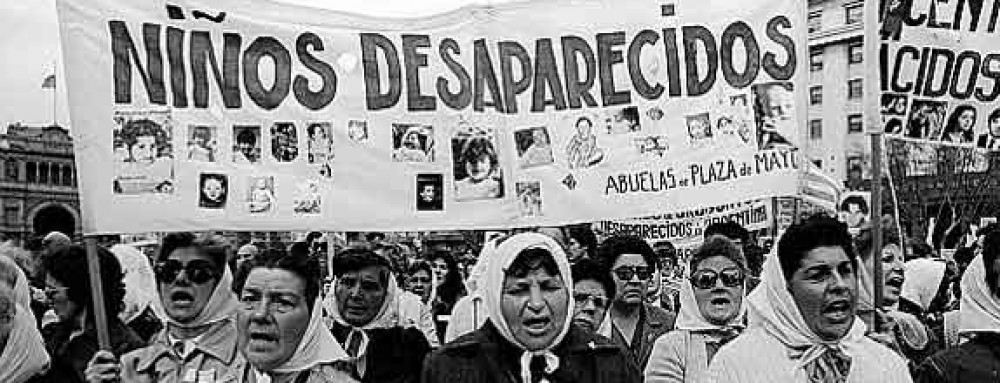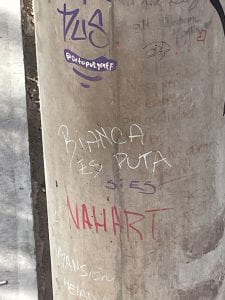I was surprised to find that ESMA was so close to residential buildings and businesses in the city. I had expected it to be more out of the way, like La Perla. Several of these buildings were there at the time of the dictatorship, so the residents may have even been aware of ESMA being used as a detention center. So many more of these sites were in places where people lived or traveled past than I expected. It was also interesting to learn that under Menem’s presidency, ESMA was supposed to be torn down and developed, becoming just another part of the surrounding neighborhood, all evidence of atrocities committed simply erased. I’m glad activists were able to fight to prevent that and instead to turn it into a memory site, and that their voices were heard. I feel like the site would have likely been built over if it was in the U.S., sadly, as there is a tendency to gloss over any negative history. It is also a contrast to Club Atlético. While also a memory site, it had a highway built over it, in an attempt by the dictatorship to erase the history, whether intentional or not, and seems to not be getting many resources to uncover more of the buried space.
Author Archives: mia_k
Reflection on Club Atlético
Club Atlético, buried under a highway in Buenos Aires, was never an athletic club at all: it was a euphemistically named secret torture site, one of many around Argentina. It was formerly the basement of a police building. Like many others, it displayed photos of its victims who never returned home. At first, you are overwhelmed by the wall of faces, but then your eyes begin to settle on individual people. There was another installation involving only names, but I find that the photos tell the people’s stories and humanize them in a unique way. This site also had objects left behind when the site was abandoned, which made what happened feel more concrete. Something else that I thought was important was that it included a map showing the United States’ role in installing dictators not just in Argentina but across Latin America through Plan Condor. This is not just Argentina’s history but U.S. History and needs to be taught and understood in the U.S. as well. I don’t believe many Americans know about this at all, and I only learned about it later on in high school, in a specific Latin American history class. While I’m glad I was taught about it, it was interesting it only came up in Latin American history and not U.S. history. We claim to be about freedom and democracy, yet have installed dictators all over the world to further our interests. This is yet another example of why it is important not to whitewash history, and why the latest attacks on education in the U.S. are so harmful. We have discussed how not all schools in Argentina teach about human rights, though they’re supposed to, but at the same time Black history, anything LGBTQ related and even a variety of books are being banned in parts of our own country. It’s important to learn about human rights issues across the world, but we must remember they are not something that happen solely in other countries, unrelated to us.
Memory All Around Us
Walking through the city with a few others as we returned from the artist market, we caught sight of this graffiti featuring “Nunca Mas” and the instantly recognizable headscarf of the Madres of the Plaza de Mayo. We had nearly missed it among the other graffiti covering the walls. I found I have learned a lot about the political climate in Còrdoba and the larger country from looking at the messages left as graffiti around the city, plus it has helped me with reading in Spanish. Seeing this and several similar works while out last night made it clear that the terrors of the dictatorship are still on people’s minds, and it has been woven into the fabric of the city. Graffiti is a valuable way of seeing what is on people’s minds in any given place, and is a good art form for processing experiences and advocating for change. It is seen as disruptive when in many cases, that is the point. It is a creative way for anyone to make themselves heard. In “Sources and Expression of Resilience in Trauma Survivors,” Harvey and Tummala-Narra state that resilience and self-healing, while important, is only part of the story for survivors. They are also fighting for justice and change, so what happened to them will not happen again. The phrase Nunca Mas (“never again”), popularized by the 1984 report, and the fight of the Madres encapsulate the importance of not just resilience but justice perfectly.
La Cumbrecita
Today was a beautiful day in La Cumbrecita, small town in the mountains outside of the city. One of the most stunning sites was the Lago de las Truchas where we ate lunch. The water was so beautiful, clear, and inviting and it had a calming effect after the heaviness of yesterday. We made some dog friends! The waterfall was also beautiful to see. It felt extra special because I genuinely was not sure I would make it up all of those rocks, but I did. I am currently exhausted but proud of myself for making it.
Clothing of the Disappeared
Today we went to the D2 detention center, a former police station that was used to hold disappeared people before transferring them to prison or a death camp. The explanation of the events that transpired during these gross violations of human rights during the dictatorship detailed in Nunca Mas gave me a greater understanding of what took place, but visiting the detention center made it feel more real. It was a powerful experience but a moment was particularly touching for me was seeing some of the clothes of the disappeared women displayed in the center. Clothing can tell a lot about a person’s life and personality, and is often underappreciated as a mode of self-expression. I tend to use clothes to express myself, and I feel like just by my clothes a person could learn a lot about me. In this case, it served to humanize the victims and to allow me to picture them in my mind more so than even photos alone. The use of clothing should be considered as a mode of storytelling for similar sites in the future, allowing for people to have a deeper understanding of who is impacted by human rights violations.






